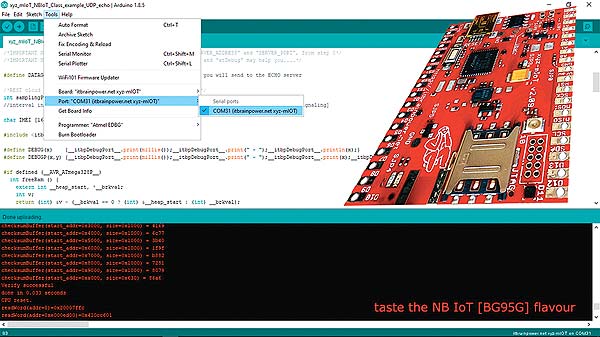 What is NB IoT technology anyway?
What is NB IoT technology anyway?
The NB IoT technology reaches the long range, has a better indoor coverage (164dB link budget), low power and high density goals by downsizing the system bandwidth to 200kHz, by using DSSS modulation and by having Guard band and In Band as Operation Modes. Also, some other LPWR techniques as PSM and i-e-DRX make NB IoT the technology of choice for very low rate and infrequent data transmission. Good to know, though, that not all NB IoT caracteriscs are on the right side – the above mentioned performaces come together with big latecy (up to 10 seconds) and small data bit rates (up to ~200kbits/~200kbits UL/DL)) − according to your application specifications it may be possible that LTE CAT-M1 usage be more convenient compared with NB IoT.
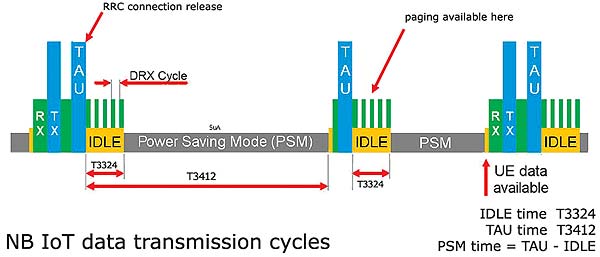 Due to mobile market evolution and limited radio spectrum, the MNOs (mobile network operators) are forced to shutdown the 2G and 3G support − not necessarily in this order − and to migrate to newer communication technologies as 5G. Good to know – existing LTE/4G technologies, including LTE Low Power (NB IoT and LTE CAT M1), will be supported by 5G networks. Weighting those, we can estimate the life span of NB IoT and LTE CAT M1 to 20-25years. Obviously, now is the right time to invest in IoT technologies based on NB IoT and LTE CAT M1.
Due to mobile market evolution and limited radio spectrum, the MNOs (mobile network operators) are forced to shutdown the 2G and 3G support − not necessarily in this order − and to migrate to newer communication technologies as 5G. Good to know – existing LTE/4G technologies, including LTE Low Power (NB IoT and LTE CAT M1), will be supported by 5G networks. Weighting those, we can estimate the life span of NB IoT and LTE CAT M1 to 20-25years. Obviously, now is the right time to invest in IoT technologies based on NB IoT and LTE CAT M1.
Testing NB IoT data transmission, how to
This NB IoT test will be exemplified using the xyz-mIoT shield equipped with Quectel BC95G module, PN: XYZMIOT209#BC95-UFL-xxxxxxx, and will consist in 4 steps (around 15-20 minutes).

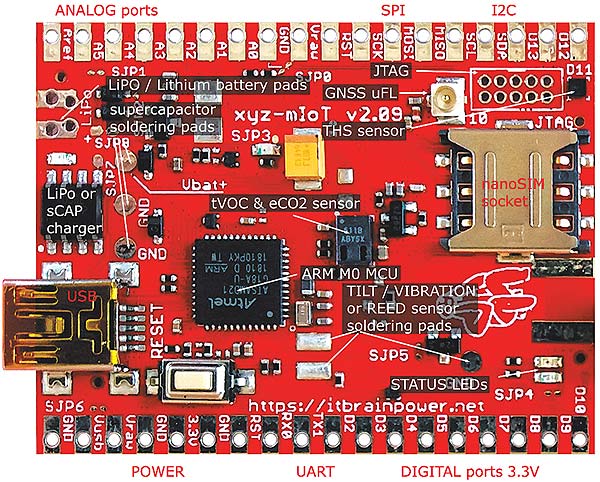 Driven by the power and versatility of the embedded ARM0 (ATSAMD21G) core and equipped with various interfaces [I2C, SPI, UART, 13 digital I/O – 1WIRE and PWM capable, 5 analog inputs and more], “xyz-mIoT by itbrainpower.net” provides multiple interfaces in order to support wide range of devices, sensors and actuators.
Driven by the power and versatility of the embedded ARM0 (ATSAMD21G) core and equipped with various interfaces [I2C, SPI, UART, 13 digital I/O – 1WIRE and PWM capable, 5 analog inputs and more], “xyz-mIoT by itbrainpower.net” provides multiple interfaces in order to support wide range of devices, sensors and actuators.
The xyz-mIoT shield may have up to 5 built-in sensors such as: THS (temperature and humidity sensors) − HDC2010, tVOC & eCO2 (air quality sensor − CO2 total volatile organic compounds − CO2 equivalent) − CCS811, HALL (magnetic sensor) − DRV5032 or IR (infrared sensor) KP-2012P3C, secondary IR (infrared sensor) − KP-2012P3C, TILT (movement vibration sensor) or REED (magnetic sensor) − SW200D. Sensors collection that populates the xyz-mIoT board can be ordered using different Part Numbers.
The xyz-mIoT shield was designed and it is manufactured in EU by itbrainpower.net team.
In order to perform the NB IoT data transmission test, the following items are required: 1 x capacitor 1000-2200uF/6.3V low ESR, one GSM antenna with uFL connector (or one uFL to SMA F pigtail and one GSM antenna with SMA) and, obvious, one SIM card having NB IoT support (in our tests we used Vodafone Romania SIM card).
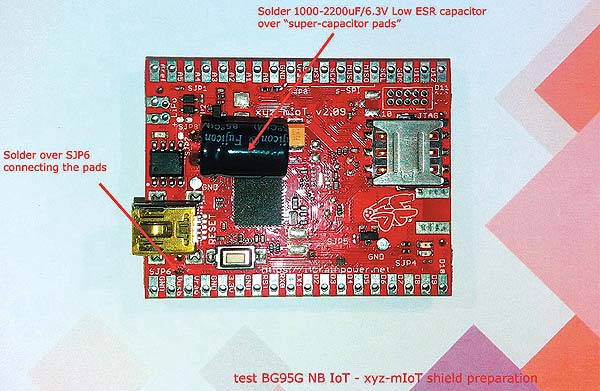 NB IoT BG95G test step 1 [hardware preparation]:
NB IoT BG95G test step 1 [hardware preparation]:
a. Solder over the SJP6 pads. By doing this, the xyz-mIoT shield will be powered from USB 5V.
b. Solder the electrolitic capacitor on Vbat and GND super-capacitor pads (see the right image).
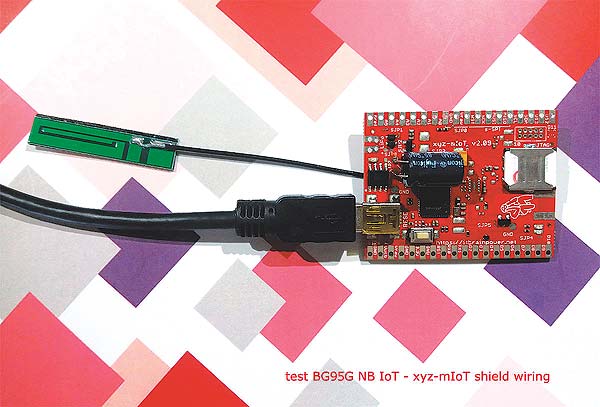 NB IoT BG95G test step 2 [put hardware together]:
NB IoT BG95G test step 2 [put hardware together]:
Insert the NB IoT nano-SIM in the xyz-mIoT SIM slot. Usually, data SIMs came without PIN code checking. Otherwise, disable the PIN code check option [directives here: https:// itbrainpower.net/FAQ/].
Connect the GSM antenna with the xyz-mIoT shield.
Using one USB type mini B cable, wire the xyz-mIoT developing board to your computer.
NB IoT BG95G test step 3 [download and install software. preliminary settings]:
Compiling and software upload will be performed in Arduino.cc (v> 1.8.5 ).
a. Download and install “xyz-mIoT shields Arduino class” available, for registered users, here: https://itbrainpower.net/downloads.php #xyz-mIoT . Installing guidelines are specified in download page.
b. Download and install “NB IOT [UDP mode] support for xyz-mIoT/u-GSM shields” available at same web address.
c. Install “udp_echo.py” listenerul (demo UDP service that simple returns the received datagram) available in “NB IOT [UDP mode] support for xyz-mIoT/u-GSM shields” package or, online at: https://itbrainpower.net/downloadables/udp_echo.py. Write down IP address și UDP PORT listner parameters.
d. Update some parameters in h files inside “itbpNBIoTClass”:
▶ in “itbpGPRSIPdefinition.h” update the NETWORKID (numeric network id code) for your NB IoTprovider – Eg.:”22601″ for Vodafone Romania.
▶ in same file, update the SERVER_ADDRESS and SERVER_PORT with values from step c (echo listener, up-here).
▶ in same file, update the LTE_BAND with LTE band used by your NB IoT provider – Eg.: 20 – Vodafone Romania use LTE B20 band.
▶ in “itbpGSMdefinition.h” set xyzmIoT as value for _itbpModem_parameter(lines 60-61).
▶ in same file, lines 64-65, chose BG95G as value for _Qmodule_.
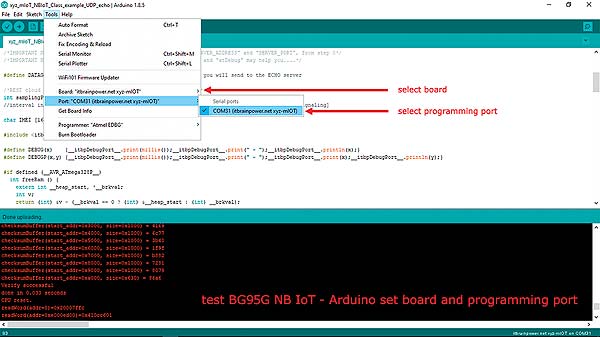 NB IoT BG95G test step 4 [compile and upload the software. run the test]:
NB IoT BG95G test step 4 [compile and upload the software. run the test]:
a. Open “xyz_mIoT_NBIoT_Class_example_UDP_echo.ino” project in Arduino.cc (version >=1.8.5) from Arduino “File/Examples/ itbpNBIoTClass” menu.
b. Select xyz-mIoT board and programming port in Arduino (see below image). In order to activate programming mode press twice (fast) the xyz-mIoT shield RESET switch.
c. Compile and upload the software.
Use Arduino console, or other serial console, to receive the debug messages. Set serial parameters to 57600bps, 8N, 1.
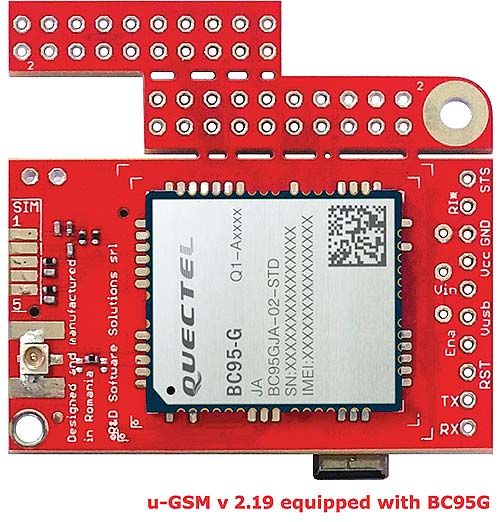 After the demo project is uploaded, the xyz-mIoT shield, will perform the data exchange process at each 10 minutes.
After the demo project is uploaded, the xyz-mIoT shield, will perform the data exchange process at each 10 minutes.
Network connecting steps, send datagram, the received one and swich between NB IoT transmission stages [ENTER ACTIVE MODE, ENTER IDLE MODE/LEAVE ACTIVE MODE and ENTER PSM MODE] will be shown into debug console. Same, the xyz-mIoT shield LEDs will signalize ACTIVE, IDLE and PSM modes.
As alternative, the very same NB IoT tests may be performed using the u-GSM modular modem shield equipped with Quectel BC95G, PN: UGSM219-BC95G#UFL.
More details and info about NB IoT test, including guidelines for u-GSM shield usage, can be seen here: https://itbrainpower.net/ a-gsm/ BC95G-NBIoT-data-transmission-how-to
R&D Software Solutions – Romanian embedded hardware and software solution provider – implements their original and innovative concepts and ideas into smart IoT platforms and solutions. Our Low Power LTE/LTE/3G/GSM modems design allows engineers to implement IoT solutions by facile integration with SBCs (single-board computers as Raspberry PI, BeagleBone Black, other..) Arduino shields and other micro-controllers. Deeply involved in innovation, R&D Software Solutions received in 2006 as acknowledgement for its innovative ideas, the “GST SSC Bronze Award” between competitors like: IBM, Computer Associates, 17 European Universities and a batch of SME.
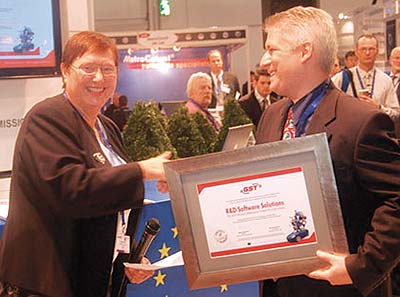 We are looking for distributors.
We are looking for distributors.
Universities and high schools may apply for permanent 40% discounts for all our IoT products. Write to us in order to join our educational program.
Orders can be done via https://itbrainpower.net/order or contact us via email: dragos@rdss.ro
Autor: Dragos Iosub, R&D Software Solutions
https://itbrainpower.net | dragos@rdss.ro | +40 745 611 611


